It's 8 March and International Women's Day. For us, it is a day that celebrates womanhood and women's rights. One of our favourite sites is Women Pioneers Film Project, an incredible treasure of interesting essays, profiles and resources. For today's post, we selected 20 American women who both worked in front of and behind the camera during the silent film era, and whose profile can be found at WPFP. Part 2 of our post, on European women film pioneers, will be online at EFSP on 25 May, when the 10th Women and the Silent Screen Conference starts, hosted by Eye Filmmuseum in Amsterdam.

Leah Baird. British postcard by Cinema Chat. Photo: Artco. Baird was interested in bringing women’s issues to the screen, a commitment exemplified by such Leah Baird Productions, Inc. titles as The Bride’s Confession (1921), Don’t Doubt Your Wife (1922), When Husbands Deceive (1922), Destroying Angel (1923), and Is Divorce a Failure? (1923). For more on Leah Baird, see Women Pioneers Film Project

Bessie Barriscale. American postcard. Photo: Evans. Like many other film actresses, Barriscale capitalised on her fame and formed her own star company. The Bessie Barriscale Feature Company released eight films in 1918. It is difficult to determine Barriscale’s exact function within the company, beyond her role as leading lady and figurehead, but a newspaper suggested she had script control. See Women Pioneers Film Project

Grace Cunard. British postcard. Photo: Transatlantic-Film Co., Ltd., the British distributor for Europe for Universal's films in the 1910s. Cunard was one of Universal's most important serial queens in the 1910s. Typical for the pioneer years, Cunard also wrote some 100 film scripts, directed 11 films and produced two others. See Women Pioneers Film Project

Marie Dressler. Promotion card for Il Cinema Ritrovato, Bologna, 2017. Photo: publicity still for The Patsy (King Vidor, 1928) with Marie Dressler (second from right) and with Jane Winton, Orville Caldwell, Marion Davies and Dell Henderson. See: Women Pioneers Film Project

Gene Gauntier. American postcard. Photo: Kalem. During the years 1907-1912, Gene Gauntier, the first 'Kalem Girl', was the preeminent figure at the Kalem Film Manufacturing Company. She played key roles in the events that comprise established film history. She wrote the scenario for Ben Hur (1907), the work involved in the controversy that established the first copyright laws covering motion pictures, performed in 87 films and is credited as the director of The Grandmother (1909). See: Women Pioneers Film Project.

Lillian Gish. German postcard by Ross-Verlag, no. 3545/1, 1928-1929. Photo: United Artists. In 1920, Lillian Gish both delivered a landmark performance in D.W. Griffith’s Way Down East and directed her sister Dorothy Gish in Remodelling Her Husband. This was her sole director credit in a career as a screen actor that began with An Unseen Enemy in 1912 and ended with The Whales of August in 1987. See: Women Pioneers Film Project.

Corinne Griffith. French postcard by A.N. (A. Noyer), Paris, no. 124. Photo: Bird. Corinne Griffith found success as an actress, producer, author, real estate magnate, anti-income-tax crusader, painter, and composer. Contracts and letters on file in the Warner Brothers Archives show that arrangements between Corinne Griffith Productions and her distributors, First National Pictures and United Artists, awarded her a relatively high amount of oversight. See: Women Pioneers Film Project.

Florence Lawrence. British postcard, no. 34. Photo: Lubin. Lawrence was known as 'the Biograph girl'. With her husband, Harry Solter, she later started one of the first US film companies to be headed by a woman: the Victor Company. See Women Pioneers Film Project

Cleo Madison. British postcard, 1915. Photo: Trans-Atlantic Film Company. Madison in The Trey o'Hearts (Wilfred Lucas, Henry MacRae, 1914). Madison’s acting career began in stock theatre and vaudeville. Universal hired her in 1913, and her performance in the dual role of good and evil twin sisters in the popular serial The Trey o’ Hearts (1914) secured her celebrity the following year. Beginning in 1915, she directed as well as acted in sixteen shorts and two features. See Women Pioneers Film Project.
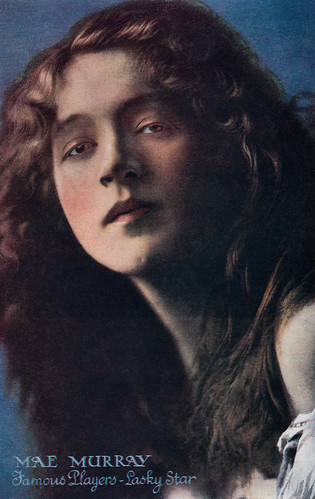
Mae Murray. British postcard. Photo: Famous Players-Lasky. In 1922 Murray and her husband Robert Z. Leonard signed with Louis B. Mayer to make films for MGM under the Tiffany label, producing eight elaborate showcases for Murray’s extravagant and florid performance style. See Women Pioneers Film Project.

Alla Nazimova. British postcard in the Picturegoer series, London, no. 203. Working under contract with Metro Pictures Corporation between late 1917 and April 1921, her company, Nazimova Productions, produced nine largely profitable, feature-length films and brought along the writing talent of writer-producer June Mathis. See Women Pioneers Film Project.

Mabel Normand. American postcard by Keystone cards, presented with Home Weekly. Photo: Keystone Film. Publicity still for Fatty's Wine Party (Roscoe 'Fatty' Arbuckle, 1914) with Normand and Fatty Arbuckle. Caption: A Ticklish Moment. Mabel Normand starred in at least one hundred and sixty-seven film shorts and twenty-three full-length features, mainly for Mack Sennett’s Keystone Film Company, and was one of the earliest silent actors to function as her own director. See Women Pioneers Film Project.
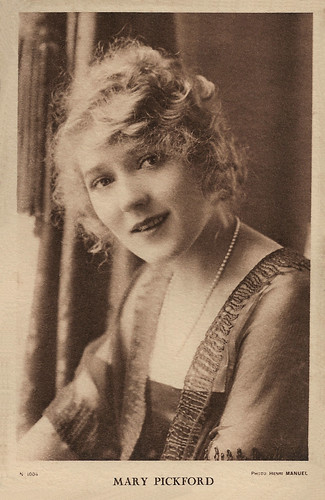
Mary Pickford. French postcard by Edition de la Cinématographie Française, Paris, no. 1004. Photo: Henri Manuel. In 1919, when she was only twenty-seven years old, Pickford cofounded United Artists, the first independent film distribution company along with Charlie Chaplin, D. W. Griffith, and her future husband Douglas Fairbanks. See Women Pioneers Film Project.

Anita Stewart. German postcard by Ross Verlag, no. 727/1. Photo: Transocean Film-Co, Berlin. Stewart began her career as an actress at the Vitagraph Company in 1911, and rose to become one of the most popular stars of the teens. In 1918 she started Anita Stewart Productions, in partnership with Louis B. Mayer, and began to produce her own feature films for First National Exhibitors Circuit. Anita Stewart Productions produced seventeen feature films between 1918 and 1922. See
Women Pioneers Film Project.
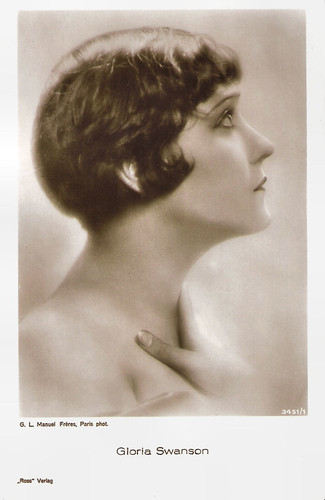
Gloria Swanson. German postcard by Ross Verlag, no. 3451/1, 1928-1929. Photo: G.L. Manuel Frères, Paris. By the time Swanson started her own production company, she had already been part of the film industry for over a decade. Many actresses started their own production companies in the 1920s and 1930s in an effort to gain more artistic freedom and a bigger percentage of the profits. Rarely, however, were actresses involved in the day-to-day workings of such an arrangement. Directors, husbands, or studio heads usually handled details. Gloria Swanson, however, remains an exception as she handled the business side of her first company; she did it not for 'artistic freedom' but, according to Swanson herself, in retaliation against Jesse Lasky. See Women Pioneers Film Project.
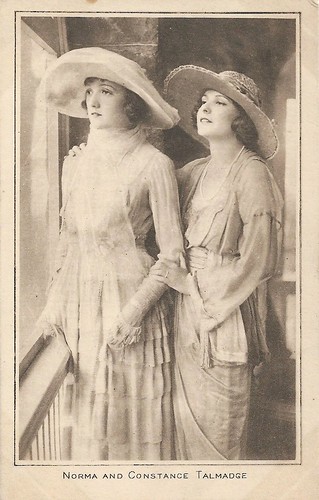
Constance and Norma Talmadge. British postcard by Pictures Ltd., London in the 'Pictures' Portrait Gallery, no. 195. The Talmadge sisters were two of the most beloved stars of the silent era. Norma’s career took an important turn when she met self-made millionaire Joseph M. Schenck, who wanted to produce motion pictures and was looking for a star. He set up the Norma Talmadge Film Corporation in New York. Their first production, Panthea (1917), about a young Russian pianist who gives up her honour to save her husband, was a huge popular and critical success. See Women Pioneers Film Project.

Alice Terry. British postcard by Ross Verlag, no. 3538/1. Photo: Metro-Goldwyn-Mayer. Publicity still for The Garden of Allah (Rex Ingram, 1927) with Ivan Petrovich. Alice Terry is probably best known to silent cinema historians in relation to the men with whom she frequently worked — Rudolph Valentino, in The Four Horsemen of the Apocalypse (1921) and The Conquering Power (1921); Ramon Novarro, in Scaramouche (1923) and The Arab (1924); and her husband, Rex Ingram, who directed Terry in all of these films as well as eight others. 'Rex and His Queen' were one of the more celebrated director-actress teams of the 1920s, but there are indications that performing was only one dimension of Terry’s contribution to their work together. The most concrete acknowledgement of this behind-the-camera labour is found in their last film, Baroud (1932), in which she did not appear but for which she received on-screen co-directorial credit. See: Women Pioneers Film Project.
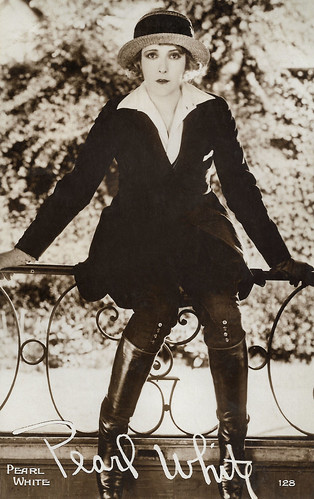
Pearl White. French postcard by Editions Cinémagazine, no. 128. Commonly known as the Pathé Frère company’s 'Peerless Fearless Girl', or the 'Heroine of a Thousand Stunts', Pearl White’s undaunted and adventurous persona became emblematic for her career and for serial queens by and large. She achieved her breakthrough in 1914 as Pauline in The Perils of Pauline, Pathé’s first serial. The Perils of Pauline is still the best-known production from the American serial craze featuring a new and independent female type of protagonist within a sensational, action-packed framework. See: Women Pioneers Film Project.

Clara Kimball Young. British (Scottish) postcard. Photo: Hardie, Aberdeen / Walturdaw. In 1916, Clara Kimball Young became only the second female film star, after Mary Pickford, to set up her own namesake production company: the Clara Kimball Young Film Corporation. Soon after this, there was a flood of female star-producers, initiating what Karen Ward Mahar at WPFP describes as a 'second wave' of star companies, 1916–1923. See Women Pioneers Film Project.
N.B. In a reaction to this post, Marlene Pilaete writes us: "As far as I know, Helen Gardner founded the “Helen Gardner Picture Players” company in 1912 and Florence Turner founded in England the “Turner Film Company” in 1913. And maybe there were others ... So, I don’t think that Pickford and Young were the first ones."
Source: Women Film Pioneers Project.

Leah Baird. British postcard by Cinema Chat. Photo: Artco. Baird was interested in bringing women’s issues to the screen, a commitment exemplified by such Leah Baird Productions, Inc. titles as The Bride’s Confession (1921), Don’t Doubt Your Wife (1922), When Husbands Deceive (1922), Destroying Angel (1923), and Is Divorce a Failure? (1923). For more on Leah Baird, see Women Pioneers Film Project

Bessie Barriscale. American postcard. Photo: Evans. Like many other film actresses, Barriscale capitalised on her fame and formed her own star company. The Bessie Barriscale Feature Company released eight films in 1918. It is difficult to determine Barriscale’s exact function within the company, beyond her role as leading lady and figurehead, but a newspaper suggested she had script control. See Women Pioneers Film Project

Grace Cunard. British postcard. Photo: Transatlantic-Film Co., Ltd., the British distributor for Europe for Universal's films in the 1910s. Cunard was one of Universal's most important serial queens in the 1910s. Typical for the pioneer years, Cunard also wrote some 100 film scripts, directed 11 films and produced two others. See Women Pioneers Film Project

Marie Dressler. Promotion card for Il Cinema Ritrovato, Bologna, 2017. Photo: publicity still for The Patsy (King Vidor, 1928) with Marie Dressler (second from right) and with Jane Winton, Orville Caldwell, Marion Davies and Dell Henderson. See: Women Pioneers Film Project

Gene Gauntier. American postcard. Photo: Kalem. During the years 1907-1912, Gene Gauntier, the first 'Kalem Girl', was the preeminent figure at the Kalem Film Manufacturing Company. She played key roles in the events that comprise established film history. She wrote the scenario for Ben Hur (1907), the work involved in the controversy that established the first copyright laws covering motion pictures, performed in 87 films and is credited as the director of The Grandmother (1909). See: Women Pioneers Film Project.

Lillian Gish. German postcard by Ross-Verlag, no. 3545/1, 1928-1929. Photo: United Artists. In 1920, Lillian Gish both delivered a landmark performance in D.W. Griffith’s Way Down East and directed her sister Dorothy Gish in Remodelling Her Husband. This was her sole director credit in a career as a screen actor that began with An Unseen Enemy in 1912 and ended with The Whales of August in 1987. See: Women Pioneers Film Project.

Corinne Griffith. French postcard by A.N. (A. Noyer), Paris, no. 124. Photo: Bird. Corinne Griffith found success as an actress, producer, author, real estate magnate, anti-income-tax crusader, painter, and composer. Contracts and letters on file in the Warner Brothers Archives show that arrangements between Corinne Griffith Productions and her distributors, First National Pictures and United Artists, awarded her a relatively high amount of oversight. See: Women Pioneers Film Project.

Florence Lawrence. British postcard, no. 34. Photo: Lubin. Lawrence was known as 'the Biograph girl'. With her husband, Harry Solter, she later started one of the first US film companies to be headed by a woman: the Victor Company. See Women Pioneers Film Project

Cleo Madison. British postcard, 1915. Photo: Trans-Atlantic Film Company. Madison in The Trey o'Hearts (Wilfred Lucas, Henry MacRae, 1914). Madison’s acting career began in stock theatre and vaudeville. Universal hired her in 1913, and her performance in the dual role of good and evil twin sisters in the popular serial The Trey o’ Hearts (1914) secured her celebrity the following year. Beginning in 1915, she directed as well as acted in sixteen shorts and two features. See Women Pioneers Film Project.

Mae Murray. British postcard. Photo: Famous Players-Lasky. In 1922 Murray and her husband Robert Z. Leonard signed with Louis B. Mayer to make films for MGM under the Tiffany label, producing eight elaborate showcases for Murray’s extravagant and florid performance style. See Women Pioneers Film Project.

Alla Nazimova. British postcard in the Picturegoer series, London, no. 203. Working under contract with Metro Pictures Corporation between late 1917 and April 1921, her company, Nazimova Productions, produced nine largely profitable, feature-length films and brought along the writing talent of writer-producer June Mathis. See Women Pioneers Film Project.

Mabel Normand. American postcard by Keystone cards, presented with Home Weekly. Photo: Keystone Film. Publicity still for Fatty's Wine Party (Roscoe 'Fatty' Arbuckle, 1914) with Normand and Fatty Arbuckle. Caption: A Ticklish Moment. Mabel Normand starred in at least one hundred and sixty-seven film shorts and twenty-three full-length features, mainly for Mack Sennett’s Keystone Film Company, and was one of the earliest silent actors to function as her own director. See Women Pioneers Film Project.

Mary Pickford. French postcard by Edition de la Cinématographie Française, Paris, no. 1004. Photo: Henri Manuel. In 1919, when she was only twenty-seven years old, Pickford cofounded United Artists, the first independent film distribution company along with Charlie Chaplin, D. W. Griffith, and her future husband Douglas Fairbanks. See Women Pioneers Film Project.

Anita Stewart. German postcard by Ross Verlag, no. 727/1. Photo: Transocean Film-Co, Berlin. Stewart began her career as an actress at the Vitagraph Company in 1911, and rose to become one of the most popular stars of the teens. In 1918 she started Anita Stewart Productions, in partnership with Louis B. Mayer, and began to produce her own feature films for First National Exhibitors Circuit. Anita Stewart Productions produced seventeen feature films between 1918 and 1922. See
Women Pioneers Film Project.

Gloria Swanson. German postcard by Ross Verlag, no. 3451/1, 1928-1929. Photo: G.L. Manuel Frères, Paris. By the time Swanson started her own production company, she had already been part of the film industry for over a decade. Many actresses started their own production companies in the 1920s and 1930s in an effort to gain more artistic freedom and a bigger percentage of the profits. Rarely, however, were actresses involved in the day-to-day workings of such an arrangement. Directors, husbands, or studio heads usually handled details. Gloria Swanson, however, remains an exception as she handled the business side of her first company; she did it not for 'artistic freedom' but, according to Swanson herself, in retaliation against Jesse Lasky. See Women Pioneers Film Project.

Constance and Norma Talmadge. British postcard by Pictures Ltd., London in the 'Pictures' Portrait Gallery, no. 195. The Talmadge sisters were two of the most beloved stars of the silent era. Norma’s career took an important turn when she met self-made millionaire Joseph M. Schenck, who wanted to produce motion pictures and was looking for a star. He set up the Norma Talmadge Film Corporation in New York. Their first production, Panthea (1917), about a young Russian pianist who gives up her honour to save her husband, was a huge popular and critical success. See Women Pioneers Film Project.

Alice Terry. British postcard by Ross Verlag, no. 3538/1. Photo: Metro-Goldwyn-Mayer. Publicity still for The Garden of Allah (Rex Ingram, 1927) with Ivan Petrovich. Alice Terry is probably best known to silent cinema historians in relation to the men with whom she frequently worked — Rudolph Valentino, in The Four Horsemen of the Apocalypse (1921) and The Conquering Power (1921); Ramon Novarro, in Scaramouche (1923) and The Arab (1924); and her husband, Rex Ingram, who directed Terry in all of these films as well as eight others. 'Rex and His Queen' were one of the more celebrated director-actress teams of the 1920s, but there are indications that performing was only one dimension of Terry’s contribution to their work together. The most concrete acknowledgement of this behind-the-camera labour is found in their last film, Baroud (1932), in which she did not appear but for which she received on-screen co-directorial credit. See: Women Pioneers Film Project.

Pearl White. French postcard by Editions Cinémagazine, no. 128. Commonly known as the Pathé Frère company’s 'Peerless Fearless Girl', or the 'Heroine of a Thousand Stunts', Pearl White’s undaunted and adventurous persona became emblematic for her career and for serial queens by and large. She achieved her breakthrough in 1914 as Pauline in The Perils of Pauline, Pathé’s first serial. The Perils of Pauline is still the best-known production from the American serial craze featuring a new and independent female type of protagonist within a sensational, action-packed framework. See: Women Pioneers Film Project.

Clara Kimball Young. British (Scottish) postcard. Photo: Hardie, Aberdeen / Walturdaw. In 1916, Clara Kimball Young became only the second female film star, after Mary Pickford, to set up her own namesake production company: the Clara Kimball Young Film Corporation. Soon after this, there was a flood of female star-producers, initiating what Karen Ward Mahar at WPFP describes as a 'second wave' of star companies, 1916–1923. See Women Pioneers Film Project.
N.B. In a reaction to this post, Marlene Pilaete writes us: "As far as I know, Helen Gardner founded the “Helen Gardner Picture Players” company in 1912 and Florence Turner founded in England the “Turner Film Company” in 1913. And maybe there were others ... So, I don’t think that Pickford and Young were the first ones."
Source: Women Film Pioneers Project.
No comments:
Post a Comment